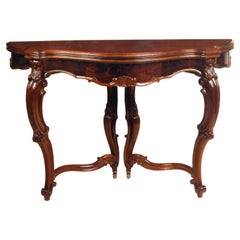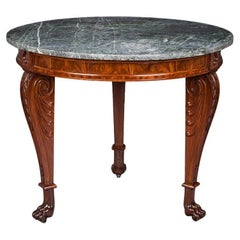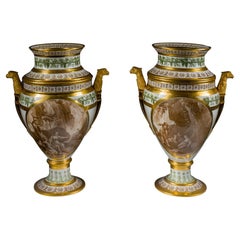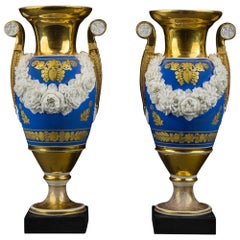Want more images or videos?
Request additional images or videos from the seller
1 of 3
Pair of Card Tables with Trestle Bases and Eagle Mounts
$125,000List Priceper set
About the Item
- Attributed to:Thomas Seymour (Manufacturer)
- Dimensions:Height: 30.88 in (78.44 cm)Width: 36.75 in (93.35 cm)Depth: 18.25 in (46.36 cm)
- Sold As:Set of 2
- Materials and Techniques:
- Period:
- Date of Manufacture:circa 1815-1817
- Condition:
- Seller Location:New York, NY
- Reference Number:1stDibs: LU90321931322
About the Seller
No Reviews Yet
Recognized Seller
These prestigious sellers are industry leaders and represent the highest echelon for item quality and design.
Established in 1952
1stDibs seller since 2010
Associations
Art Dealers Association of America
Authenticity Guarantee
In the unlikely event there’s an issue with an item’s authenticity, contact us within 1 year for a full refund. DetailsMoney-Back Guarantee
If your item is not as described, is damaged in transit, or does not arrive, contact us within 7 days for a full refund. Details24-Hour Cancellation
You have a 24-hour grace period in which to reconsider your purchase, with no questions asked.Vetted Professional Sellers
Our world-class sellers must adhere to strict standards for service and quality, maintaining the integrity of our listings.Price-Match Guarantee
If you find that a seller listed the same item for a lower price elsewhere, we’ll match it.Trusted Global Delivery
Our best-in-class carrier network provides specialized shipping options worldwide, including custom delivery.You May Also Like
Regency Pair of Card Tables with Matching Sofa Table
Located in Bradford-on-Avon, Wiltshire
A rare and fine set of Regency drawing room furniture comprising a pair of card tables and matching sofa table: made in figured mahogany; the tops ...
Category
Antique Early 19th Century English Regency Card Tables and Tea Tables
Materials
Mahogany
French Card Table with Parquetry and Gilt Bronze Mounts, 19th Century
Located in London, GB
A fine card table in the Louis XVI manner.
Constructed in kingwood with purpleheart crossbanding, and dressed with superbly cast and chased mercury gilt bronze mounts; rising from...
Category
Antique 19th Century French Louis XVI Card Tables and Tea Tables
Materials
Bronze
$25,571
H 28 in W 26.5 in D 26.5 in
Pair of William IV Card Tables
Located in Forest Row, East Sussex
A pair of William IV card tables. Solid and veneered rosewood with classical carved decoration.
Category
Antique Early 19th Century English William IV Card Tables and Tea Tables
Materials
Walnut
Georgian Mahogany Pair Of Card Tables
Located in Bedfordshire, GB
A Very Fine Pair Of Late 18th Century, Georgian, Sheraton Period Mahogany Card Tables, Of D Shaped Form, Having Superbly Figured Foldover Tops With Crossbanded Satinwood Decoration A...
Category
Antique Late 18th Century English Sheraton Card Tables and Tea Tables
Materials
Mahogany
Pair of Mahogany Gothic Revival Card Tables
Located in Cheshire, GB
Pair of Gothic Revival card tables of serpentine outline fitted with swivel tops opening to reveal a baize lined interior above geometric carved freeze all raised up on four chamfere...
Category
Mid-20th Century English Gothic Revival Card Tables and Tea Tables
Materials
Wood
$3,151 Sale Price / set
29% Off
H 30.5 in W 38.5 in D 20.5 in
A Fine Pair of French Marquetry Card Tables
Located in Lincolnshire, GB
A super pair of mid 19th century walnut and kingwood marquetry card tables retaining the original red leather to the inside. Fine ormolu mounts and great colour and patina
Circa 1845
Category
Antique Mid-19th Century French Card Tables and Tea Tables
Materials
Ormolu
Pair of Kingwood Card Tables by G. Durand
By Gervais Durand
Located in Lymington, Hampshire
A pair of kingwood card tables by G. Durand, each with a shaped folding top above a serpentine frieze and elegant cabriole legs with gilt bronze foliate mounts, edges and sabots, dec...
Category
Antique 1890s French Card Tables and Tea Tables
Materials
Kingwood
Pair of Rosewood Card Tables, circa 1820
Located in Bradford-on-Avon, Wiltshire
A fine pair of Regency card tables, the tops and friezes with delicate brass inlays; good pale color.
Category
Antique 19th Century British Regency Tables
Materials
Rosewood
Ormolu-Mounted Rosewood and Mahogany Folding Card Table by Sormani
By Paul Sormani
Located in London, GB
Fold over card table on interlaced stem with quatrefoil base scroll legs.
Category
Antique Mid-19th Century French Card Tables and Tea Tables
$13,131
H 30.32 in W 19.69 in D 19.69 in
19th Century French Ebonized Folding Card Table with Bronze Mounts
Located in Miami, FL
19th century Marquetry card table, the rectangular top centered with an inlaid cartouche and musical instruments, within swept foliate inlay, the top opening to a baize lined playing...
Category
Antique Late 19th Century French Louis XV Card Tables and Tea Tables
Materials
Bronze
$5,975
H 31.11 in W 36.62 in D 36.62 in
More From This Seller
View AllCard Table in the Rococo Taste
By Charles A. Baudoine
Located in New York, NY
RECORDED: cf. Anna Tobin D’Ambrosio, ed., Masterpieces of American Furniture from the Munson-Williams-Proctor Institute (Syracuse University Press, Utica, New York, 1999), pp. 85, 86, 87 illus. the Munson-Williams-Proctor tables // cf. The Metropolitan Museum of Art, New York, 19th Century America–Furniture and Other Decorative Arts (1970), exhib. cat., [n.p.] no.133
This table is identical to a pair of card tables bearing the stenciled label of Charles A. Baudouine of 335 Broadway, New York, which were acquired by James and Helen Munson Williams of Utica, New York, in May 1852 for their home, Fountain Elms, which is where they remain today as part of the Munson-Williams-Proctor Art Institute collection. The Williams tables were billed as “1 Rosewood Multiform Table” at $160 for the pair, and they were indeed “multiform” in that they could be used separately and folded as a pair of console tables, opened as a pair of card tables, or joined together as a center table. The present table varies essentially in the fact that it does not include the mechanism that would have allowed it to be attached to another to form a center table.
Of French descent, Baudouine was born in New York in 1808. He made his debut as a cabinetmaker in the New York directory of 1829/30, where he is listed at 508 Pearl Street. By 1839/40 he relocated to Broadway, where he remained in business at various addresses until about 1854. A sense of the scale of Baudouine’s operation is given by German immigrant cabinetmaker Ernest Hagen...
Category
Antique Mid-19th Century North American Rococo Revival Card Tables and T...
Materials
Wood, Rosewood
Center Table with Scroll Legs, Paw Feet and Marble Tops
By Thomas Seymour
Located in New York, NY
Center Table, about 1818–20
Attributed to Thomas Seymour (1771–1848), working either for James Barker or for Isaac Vose & Son, with Thomas Wightman (1759...
Category
Antique 1810s American American Classical Center Tables
Materials
Wood, Mahogany
Pair of Porcelain Urn Form Fruit Coolers with Covers and Liners
By Stône, Coquerel, and Legros d'Anisy
Located in New York, NY
Pair Footed Fruit Coolers, about 1810-20
Stône, Coquerel, and Legros D’Anisy, Paris (active 1808–49)
Porcelain, partially transfer printed in sepia and green and gilded
Each, 13 1/2 in. high x 10 in. wide x 7 1/2 in. deep
Signed and inscribed (on underside of one top and one base, with printed mark): STÔNE /
COQUEREL / ET / LE GROS / PARIS / PAR BREVET D’INVENTION: Manufre de Décors sur
Porcelaine Faience; variously inscribed with decorators’ initial in green and brown (on
underside of one top and one base): M; variously inscribed with incised mark (on underside of one liner and both bottoms): 3; inscribed (in blue script, on the inside of one liner): 615
The Parisian firm of Stône, Coquerel, and Legros d'Anisy is distinguished for the important role that it played in the introduction of transfer-printed decoration on fine china in France. Although the process had been known and used in Great Britain since the eighteenth century, it was, according to Régine de Plinval de Guillebon in her book, Porcelain of Paris 1770–1850 (New York: Walker and Company, 1972), not until 1802 that Potter, Blancheron, Constant, Neppel, Cadet de Vaux & Denuelle took out a patent in France for transfer-printing on earthenware, and it was only on February 26, 1808, that John Hurford Stône, his brother-in-law, Athanase Marie Martin Coquerel, and Francois Antoine Legros d'Anisy not only took out a patent for transfer-printing on china, but also established a Stône, Coquerel, and d'Anisy partnership for the manufacture of transfer-printed ceramics. Their address from 1808 until 1818 was at 9, rue de Cadran, Paris.
Prior to this, Stône and Coquerel had been partners at a creamware factory in Creil, France, and Legros d’Anisy had worked at the Sèvres factory, where he had apparently developed the transfer-printing technique for which his own firm became well known. “The process,” notes de Guillebon, was “based upon removing from the engraving a ‘pull’ made on a specially coated filter-paper, which was pressed onto the object to be decorated; this object itself was covered with a film. Firing took...
Category
Antique Early 19th Century French Neoclassical Wine Coolers
Materials
Porcelain
Pair of "Old Paris" Vases with Garlands of Bisquit Flowers
Located in New York, NY
French, circa 1820.
Porcelain, painted and gilded, with applied bisquit flowers
8 13/16 in. high.
Inscribed (with incised mark, under the base of each): 3.
Category
Antique 1820s French Neoclassical Porcelain
Materials
Porcelain
Pair Side Chairs with Lyre Back
Located in New York, NY
“I know of no other chair like the single [sic] ‘lyre back’ one. . . . I certainly recognize it as a Boston chair considering all the individual elements, but the combination is particularly elegant.” So wrote noted scholar of Boston furniture Page Talbott when a set of four chairs of this design originally surfaced in the 1980s. Although the existence of four chairs in a specific pattern might imply that the chairs were originally part of a larger set, no additional chairs of this form have appeared in the intervening years.
The lyre became a popular motif during the Neo-Classical period, and is frequently encountered as the back splat of klismos chairs, in no example more familiar than in a group of Duncan Phyfe chairs...
Category
Antique 1820s American Neoclassical Chairs
Materials
Mahogany
$30,000 / set
Pair of Medici-Form Vases
Located in New York, NY
Attributed to Schoelcher, Paris, France, circa 1830.
Porcelain, painted and gilded.
16 1/4 in. high, 9 1/2 in. wide, 9 1/2 in. deep.
Ex Coll.: by repute, Joseph Bonaparte...
Category
Antique Mid-19th Century French Empire Porcelain
Materials
Porcelain
$25,000 / set
Recently Viewed
View AllMore Ways To Browse
Antique Eagle Tables
Trestle Table Mahogany
Bronze Eagle Signed And Numbered
Used Furniture In Boston
Round Marble Table Tops
Pair French Bronze And Marble Tables With Eagles
Anthony Quervelle
Boston Card Table
Dean Antiques
Seymour Card Table
Inlaid Card Table
Fold Over Table
George Iii Mahogany Card Table
English 18th Century Game Table
Vintage Wood Card Table Tables
Rosewood Tea Table
Antique Tea Set Queen Anne
Antique Tilt Top Game Table Table



